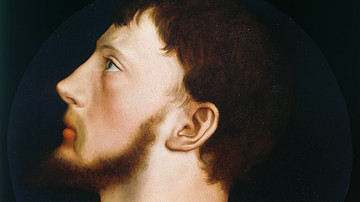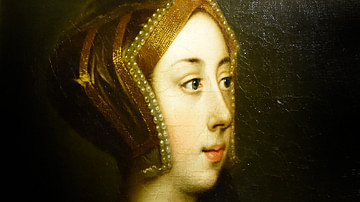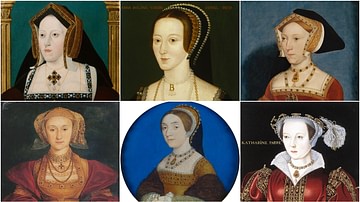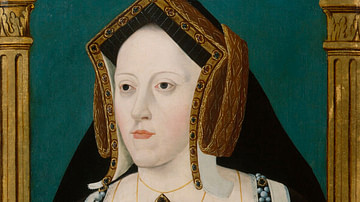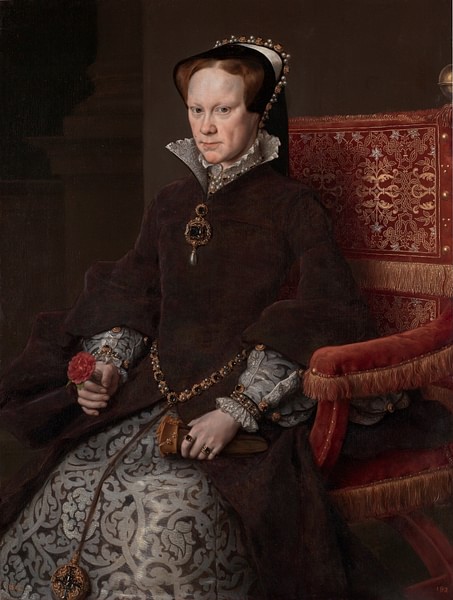
Mary I of England reigned as queen from 1553 to 1558. The eldest daughter of Henry VIII of England (r. 1509-1547) with Catherine of Aragon (1485-1536), she restored Catholicism in England while her persecution of Protestants led to her nickname 'Bloody Mary'. Mary's marriage to Philip of Catholic Spain set her own kingdom against her.
As queen regnant, Mary had to overcome the hurdle of prejudiced male courtiers and even a usurper in the form of Lady Jane Grey (1537-1554) before her reign had even begun. The queen went on to quash the Wyatt rebellion of 1554 but her support of Catholicism and Spain were her undoing. Mary died of cancer in 1558 and she was succeeded by her half-sister Elizabeth I of England (r. 1558-1603) who once more returned England to Protestantism. Elizabeth might have grabbed more of posterity's interest and acclaim but it was her sister Mary who became the first queen to rule England in her own right.
Early Life
Mary was born on 18 February 1516 at Greenwich Palace, the daughter of Catherine of Aragon and Henry VIII. Mary had a younger half-sister, Elizabeth (b. Sep. 1533), the daughter of Anne Boleyn (c. 1501-1536). She also had a younger half-brother, Edward (b. Oct. 1537), the son Henry's third wife, Jane Seymour (c. 1509-1537).
In 1531, when pressuring Catherine to divorce him so that he could marry Anne Boleyn, Henry VIII had permanently separated Mary from her mother the queen consort. After much ado, Henry's first marriage was annulled on 23 May 1533. The consequence for Mary was that she was declared illegitimate by the Act of Succession (30 April 1534). Henry married Anne Boleyn and the birth of their daughter Elizabeth saw Mary further demoted to the periphery of the king's court. Mary's mother Catherine died of cancer aged 50 in January 1536. The princess' home life improved when Henry married his sixth wife Catherine Parr (c. 1512-1548) in July 1543. Catherine Parr undertook the welfare and education of her three adopted children and the home was a happy one.
At the end of his life, Henry VIII's only male heir was his son Edward, who duly became Edward VI of England (r. 1547-1553) following Henry's death on 28 January 1547. Henry had also stipulated in 1544 that should his son die without children of his own then Edward's half-sister Mary would become queen, and after her, in the case of no other male heirs, his other half-sister Elizabeth. Mary remained a staunch Catholic despite Edward VI's moves to make England ever-more Protestant. The king even insisted his sister give up mass but Mary refused. In May 1550, Mary feared for her life and even attempted to flee to continental Europe.
The Pretender: Lady Jane Grey
In July 1553 Edward VI died aged just 15 and so his short reign had been dominated by regency councils. The latter half of Edward's reign saw John Dudley, the Earl of Northumberland (l. 1504-1553) run the government and, with Edward's approval, the English Reformation and abandonment of all things Catholic continued apace. With the king dying of tuberculosis, it looked like Mary would become queen. The problem for Dudley was that Mary was a staunch Catholic and so not only would she reverse the Reformation, she would take vengeance on its supporters, number one of whom was Dudley. Accordingly, Dudley came up with a plan to make Edward's cousin Lady Jane Grey his official heir.
Lady Jane was born in October 1537, the daughter of Henry Grey, the Duke of Suffolk (1517-1554). She had a distant royal connection as Jane was the great-granddaughter of Henry VII of England (r. 1485-1509) via her mother Frances, herself daughter of Mary Tudor, Queen of France (1496-1533), the sister of Henry VIII. Jane was also a devout Protestant. Dudley made extra sure of his future position by having Jane marry his son Lord Guildford Dudley on 21 May 1553. The plan to make Jane queen, signed by Edward, was known as the 'devise of succession' and it disinherited both Mary and Elizabeth, declaring them both bastards. The 'devise' went against Henry VIII's wishes and English law and was not approved by Parliament. It was, though, approved, with reluctance, by the King's Council. Thus, after Edward died on 6 July 1553, on 10 July, Dudley declared Lady Jane Grey, then only 16, the Queen of England. The coup would last just nine frantic days.
Mary Becomes Queen
Dudley had made two fatal mistakes. The first was not to secure Mary in the Tower of London or another suitable place of safekeeping. The second was to underestimate the feeling amongst nobles and commoners alike that royal blood and legitimacy were more important than any religious considerations. In addition, to accept the 'devise' was to put the monarch higher than Parliament and the law, a dangerous move which could incur serious problems in the future.
Mary had escaped to her stronghold in Norfolk and there, at Framlingham Castle, loyal nobles and their armies gathered in support. Mary felt confident enough to declare herself the true queen on 19 July. Eventually, a 30,000-strong force marched in Mary's name on London, and the people there and elsewhere were united that Henry VIII's original wish should be honoured. Dudley was duly deserted by the council and arrested at Cambridge on his way to try and capture Mary on 21 July. Dudley's army of 2,000 men vanished away like smoke in the wind; a last-minute declaration in support of Mary was not quite enough to save his neck; he was executed on 22 August 1553.
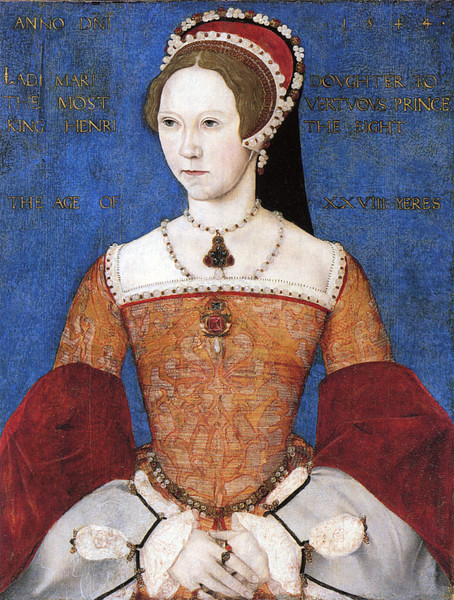
Reversing the Reformation
Mary was the popular people's choice, how strange, then, that she became known as a despot and 'Bloody Mary.' The problem was that the queen had not understood her popularity lay in her legitimacy to rule as the daughter and sister of her two predecessors as monarch respectively. Mary convinced herself that she had gained the throne because God had favoured her religious convictions. Just as her father had been determined to split the Church in England from Catholic Rome, so Mary was equally determined to return England to Catholicism.
In truth, most of the population was indifferent to the whole debate. Deference to the decisions of those in authority regarding how to best worship God was the overwhelming and uncritical sentiment. However, when politics mixed with religion, a combustible cocktail was created. Mary fuelled any underlying discontent with Catholicism by attempting to reverse her father's 1534 Act of Supremacy which had placed the English monarch at the head of the Church of England instead of the Pope. Mary wished to reinstate the Pope as the supreme religious authority. Besides this religious ideal, the practical consequences of handing back confiscated estates to the Church was not a popular one with the nobility. Secondly, and perhaps more seriously in the minds of the general populace, she sought to tie England with Spain. Both these religious and political strategies would strike against the newly burgeoning sense of nationalism in England.
Philip of Spain
On 29 October 1553, the queen announced her betrothal to Philip (l. 1527-1598), son of King Charles V of Spain (r. 1516-1556), England's Catholic enemy number one and a state growing ever-richer as it plundered the wealth of the New World. People now remembered that Mary's mother had been the daughter of King Ferdinand II of Aragon (r. 1479-1516) and Queen Isabella of Castile (l. 1451-1504). There were even rumours of a planned Spanish invasion of England. The volatile situation certainly sealed Lady Jane's fate as Mary could not afford her to become the figurehead of a plot to dethrone her. Jane was executed on 12 February 1554, and her death had come as a direct response to what had been the Tudor Dynasty's greatest challenge.
The Wyatt Rebellion
A rebel army from Kent led by Sir Thomas Wyatt marched on London on 25 January 1554 to stop the 'Spanish Marriage' and perhaps replace Mary with Elizabeth as queen. Elizabeth would then marry Edward Courtenay, the great-grandson of Edward IV of England (r. 1461-1470). As Wyatt put it, he did not want to see England become "a cockleboat towed by a Spanish galleon" (Cavendish, 283). Added to this grievance was the poor state of the country's economy. Throughout the last decades, Mary's subjects had to suffer inflation, currency debasements, a falling off of European trade, food shortages, new duties on goods like cloth, wine and beer, and waves of plague and influenza - the most fatal in three centuries.
The challenge presented by the Wyatt rebellion was so serious that Mary ordered the destruction of the bridges across the River Thames but she herself remained in her capital and gave a rousing speech to the public gathered at London's Guildhall. The queen reassured the people that she was "her father's daughter and her kingdom's wife" (Jones, 240) and London would hold firm. Then, on 6 February, Wyatt swam across the Thames and began to make repairs of one of the bridges. When the way was clear, 7,000 protestors marched into the heart of London on 17 February. The queen was prepared, though, and an army of 10,000 men and 1,500 cavalry enveloped Wyatt and his vanguard. A street battle followed in which the rebels gained the upper hand, attacking the Palace of Whitehall where the queen was resident. Eventually, the cavalry force moved in and made short work of the rebels, Wyatt surrendering along with a handful of survivors.
There had meant to be three other simultaneous rebellions, one of which was led by the Duke of Suffolk, father of Lady Jane Grey, but this, and the other two, failed to materialise. Mary suspected Princess Elizabeth of being involved in the rebellion - even if her sister had made no public statements on either the Reformation or Spanish Marriage - and so she was detained in the Tower on 17 March 1554 and, two months later, moved on to Woodstock in Oxfordshire where she was kept under house arrest. The next year the two sisters reconciled and Elizabeth was allowed her freedom back. The rebels did not get off so lightly as 200 were executed and, on 11 April, Wyatt was given the terrible traitor's death: hanged, drawn, and quartered.
The Spanish Marriage
The English Parliament was not keen on religious reforms if they undermined the wealth of the nobility but it did pass Mary's First Act of Repeal in October 1553 which reversed all the religious-aimed legislation of Edward VI. Parliament was certainly against the idea that the queen marry a foreigner, especially a Spaniard but Mary finally acquired its consent for the marriage provided Philip was only made a king during Mary's lifetime. Under this marriage treaty, Philip had no more power than a consort, and foreigners did not gain positions at court. Mary married Philip, 11 years her junior, on 25 July 1554 in Winchester Cathedral. The marriage was not a happy one as Philip - himself a pawn in his father's foreign policy - chased younger and better-looking ladies for his pleasure and the royal couple hardly ever spent any time in the same country. Mary, in contrast, was besotted with her Spanish prince. Another delusion was a pregnancy, announced by Mary in 1554 which turned out to be false hope, as did a second phantom pregnancy in 1557. Perhaps both these phantom pregnancies were really the first signs of the tumour that would eventually kill her.
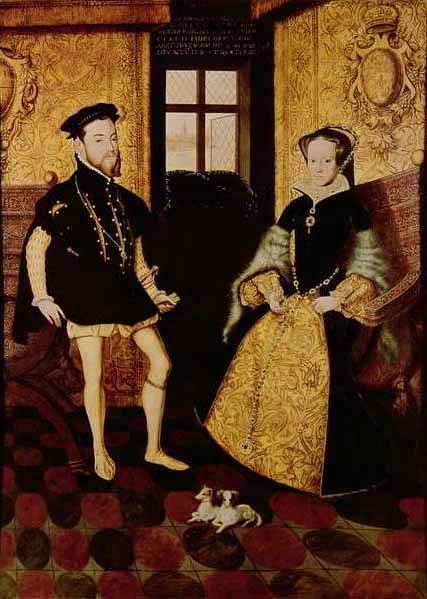
Still, Mary's marriage was not entirely a dud deal as Philip had brought with him 20 cartloads of America's silver, a much-needed boost to the mint at the Tower of London. The mint even won its first foreign contract: to punch out silver coins for Spain. Although there were a string of bad harvests from 1555 to 1558, control of the economy was more robust under Mary with better management of customs duties, revenue collection became more efficient as the Exchequer grew in independence, the currency was more appropriately valued, and the government was better run as specialised committees took on particular duties. Finally, and perhaps most importantly given events later in the century, Mary reinvested in England's naval fleet after years of neglect under her predecessor.
'Bloody Mary'
On 20 November 1554 the papal legate Cardinal Reginald Pole had formally pronounced absolution and that England and the Papacy were now at peace. These were fine words but bloody deeds would follow yet. The queen pushed through Parliament the Second Act of Repeal in January 1555 which abolished all post-1529 legislation concerning religious matters. This legislation had included the Act of Supremacy and so finally the Pope was back officially as head of the Church in England.
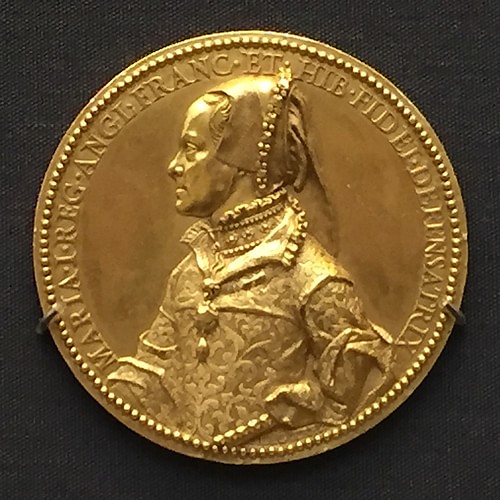
Mary was clever enough to use other strategies besides terror; education became her main weapon. The education of parish priests was carefully monitored, as were universities, new pamphlets, prayer books and Bibles were published to guide those who themselves would guide laymen. Bishops set up training schools, and decrees outlined what was now expected from the priesthood. Mary's policy was so effective that Catholicism took roots that grew so deep, her successors would struggle to disentangle them all.
Although Mary's reign was not perhaps the great moment of Tudor crisis that 20th-century historians once liked to portray, she did have to battle as a female ruler presiding over a council already split over multiple issues. The House of Commons had been largely compliant but with notable exceptions such as the outright rejection of Mary's bill of December 1555 to confiscate the estates of hundreds of exiled Protestants. The real threat of the rebellions and level of unpopularity amongst the people are difficult to measure but whatever one's position, it had all been a long struggle for the queen, and after five years of political and emotional strife, her physical well-being had suffered. Those nobles wise enough to see it prepared themselves for a new monarch.
Death & Successor
Mary, aged 42, died of stomach cancer on 17 November 1558 at Saint James' Palace. The queen's death was celebrated as an end to the religious strife that had blighted England for so long; indeed, 17 November was long-celebrated thereafter as a public holiday. Mary was buried in Westminster Abbey. With no heirs, Mary Tudor was succeeded by her half-sister Elizabeth Tudor who was crowned on 15 January 1559. Queen Elizabeth would restore Protestantism but her greatest challenge came from abroad as Catholic Spain and Philip II now saw the golden opportunity to once and for all control both the worldly wealth and the spiritual soul of England. As it happened, the gold of the Americas was wasted on a Spanish Armada fleet that could not force an invasion. The aura of gold was all on England's side as Elizabeth's reign then blossomed into one of the greatest periods of the country's long history.


